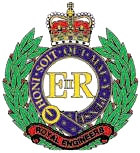



His grand-daughter Raine Bryant writes to the best of her knowledge: Julian Frederic Doelberg was born on 16th November 1901 and registered in the Lewisham District, Kent. The son of an English lady Nellie Agnes Maltby and a Prussian gentleman, Hermann Diedrich Doelberg (whose brother was Privy Auditor Councillor to Kaiser Wilhelm II.
This posed problems to Julianís elder brother Athelstone whilst at Dartford Naval College, I do not know if Julian was subject to similar discrimination. He also had a younger brother Lawrence. Hermann, a London business man, became a naturalised Briton in 1906.
Julian married Leslie Edith Havers at Bath in 1927, they had one daughter, Anne in 1932. He received his education at Eastbourne College, proceeding in 1919 to the Royal Military Academy, Woolwich.
He then entered the School of Military Engineering, where he studied constructional, mechanical, and electrical engineering. Army records show his passing of the Associate Membership Examination of the Institution of Electrical Engineers in 1922. In 1924 he went to Gosport where he attended further classes at the School of Electric Lighting. In the following year he received his commission in the Royal Engineers and became officer in charge of workshops, 1st A.A. Searchlight Battalion.
During 1928 he attended the Advanced Motor Transport Course of the Military College of Science. In 1929 he was promoted to be staff captain and served for three years in the Directorate of Mechanization at the War Office. During the next three years he served his apprenticeship with Messrs. J. I. Thornycroft, Messrs. Petters, and other firms, and also continued his technical studies.
Serving in the Royal Engineers he was stationed in Singapore in 1935 on his appointment as garrison engineer for the Western Defences of Malaya, a position which involved the supervision of various contracts for new works including the Changi barracks - which became the notorious Japanese prison camp. Photos taken at the time are now the property of Changi Museum, and at the time of donation were the only ones seen of the initial construction including water buffalo clearing the site.
Julian Frederic Doelberg
source: Raine Bryant
After recall to the UK in 1937 due to the war threat, he moved his wife Leslie and daughter Anne to 12 Clockhouse Mead, Oxshott, Surrey. Anne attended Bevendeen School in Steels Lane. He went on holiday to Germany with Leslie during which he visited German relatives and spied on German military installations. It is understood that this spying was on his own initiative and proved to be of great help to the Allied cause.
On the setting up of the Royal Electrical and Mechanical Engineers he transferred to this unit and was eventually posted to Greece with a reduction in rank to captain for a special mission. This is understood, but not proven, to be the demolition of bridges and other installations to delay the advance of the German forces during the Allied evacuation.
Allied soldiers hired a Greek ship, loaded with hay, to evacuate to Crete. As they were trying to repair the engine, around 10:00 a.m. on April 29, 1941, two German aircraft arrived and bombed the ship. Most soldiers jumped in the sea. Major Doelberg, along with six other soldiers, died and was buried by the villagers of Proastion (in southern Peloponnese) on the Kaminia (also called Delfinia) beach. The ship was completely burned and it sank.
About a year later, it was decided by the local people that the soldiers should be properly buried together in a cemetery. The local priest held a service, the bodies were exhumed and the whole village followed in procession from the beach to the cemetery, where they were all buried in a common grave.
In the autumn of 1944 a British warship arrived at Kalamitsi beach, and a military chaplain, followed by a Cypriot interpreter, went to the village, a service was held, the bones were exhumed again and were carried to the ship. Again a silent procession by the whole village followed the chaplain and the local priest to the ship. The bones were buried on April 27, 1945 at Phaleron War Cemetery in Athens ,Grave Reference 14. C. 2. The ashes of his wife and some of his daughterís ashes have been added to the grave. He is also remembered on Oxshott Church wall War Memorial, and on the memorial on Oxshott Heath.
Julianís exercise books from his initial army training have calculations and 'recipes' for making bombs and explosives. They, and his drawing instruments are now the property of the National Science Museum, London.
He invented a silent loo flush and bullet proof tyre. He tried to work out a way to save lives in a submarine, tipped up and stuck in the mud, off the English coast. (This is
most likely the HMS Thetis in June 1939, as my mother remembers him with models and air pipes in the bath, trying to find a way to rescue it, without luck. She would have been aged 7).
Julian was an exceptionally strong rugby player and is legended to have run up the field with seven men hanging off his legs and earned the nickname Tarzan.
Anne married and also lived in Clockhouse Mead in the last house on the left. Her two children also went to Bevendeen. Anne died 2008 in Cobham.His name was spelt wrongly on the War Memorial on the Heath, but I managed to get a stonemason to change it in 2007, just before my mother died, as it had upset her and her mother ever since it was erected. I wonder if there is any way of preserving the stone as the whole memorial is getting very weathered now.
page created 5 Apr 2010: updated 4 Nov 2017: if you can add to this page please contact the editor